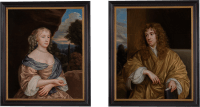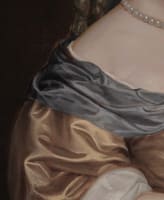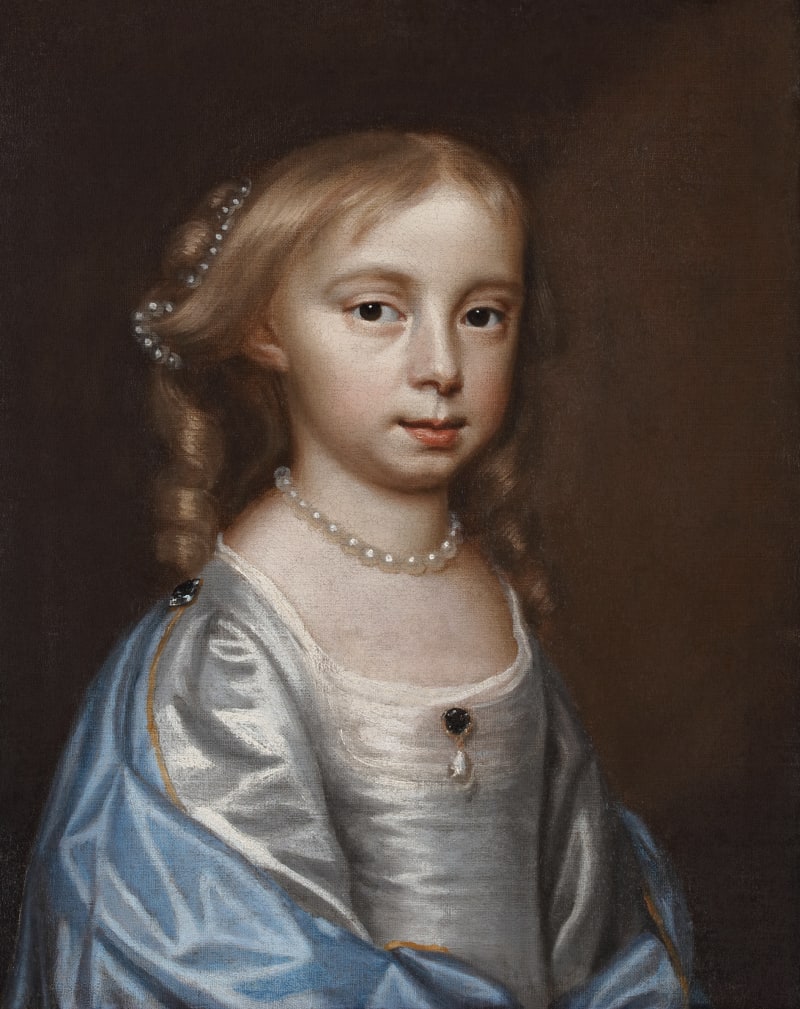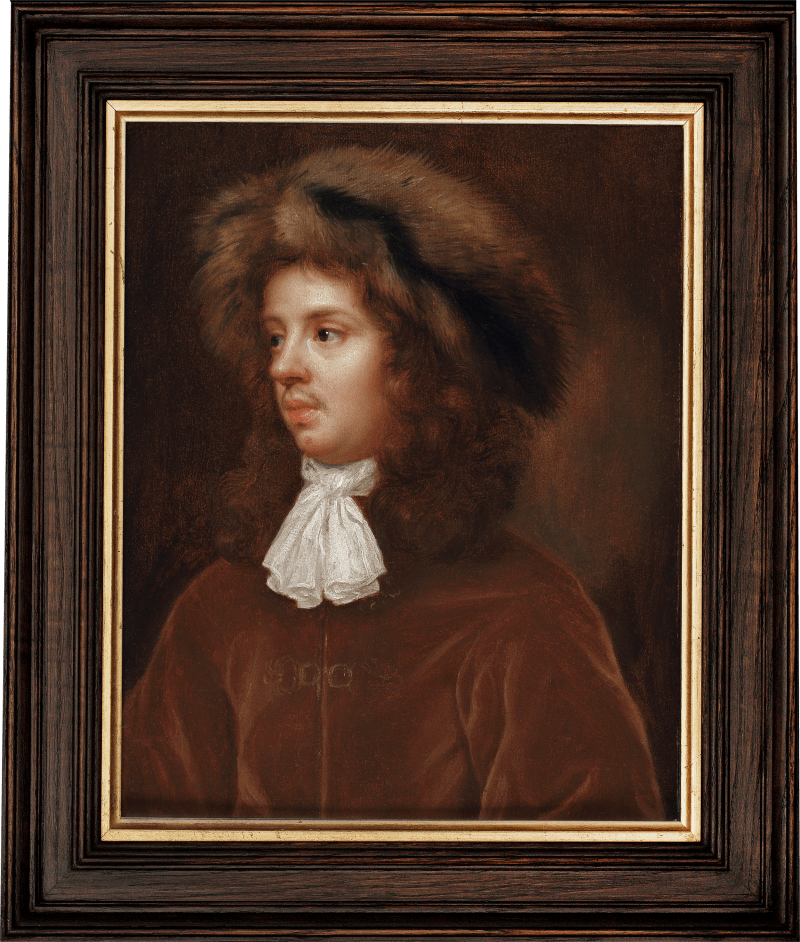This exceptional pair of recently discovered portraits can be considered among Mary Beale’s most accomplished works. They depict Samuel and Mary Woodforde, close friends of the Beale family, and were painted around five years before Beale established a professional portrait practice in London. They represent a highly important addition to Beale’s oeuvre and are rare surviving examples of works dateable to her time in Suffolk between 1664 and 1670. The outstanding condition of both works allows a privileged insight into her lyrical painting style at this date – a characteristic absent in many of her later works, which were often painted in collaboration with assistants.
The clergyman and prolific diarist Samuel Woodforde was a beloved friend and confidante of the Beale family. Their lives became intertwined when he fell in love with Charles Beale’s first cousin, Alice Beale, whom he married on 10 October 1661. The young couple became lodgers at the Beale home, living communally at Hind Court,...
This exceptional pair of recently discovered portraits can be considered among Mary Beale’s most accomplished works. They depict Samuel and Mary Woodforde, close friends of the Beale family, and were painted around five years before Beale established a professional portrait practice in London. They represent a highly important addition to Beale’s oeuvre and are rare surviving examples of works dateable to her time in Suffolk between 1664 and 1670. The outstanding condition of both works allows a privileged insight into her lyrical painting style at this date – a characteristic absent in many of her later works, which were often painted in collaboration with assistants.
The clergyman and prolific diarist Samuel Woodforde was a beloved friend and confidante of the Beale family. Their lives became intertwined when he fell in love with Charles Beale’s first cousin, Alice Beale, whom he married on 10 October 1661. The young couple became lodgers at the Beale home, living communally at Hind Court, London. The diaries kept by Woodforde during this period are revealing; Dr. Helen Draper notes: ‘From Woodforde’s diary we come to understand the independence and agency that Mary exercised, not only in her work, but in everyday life. Possessed of her own set of house keys, she came and went as she pleased, visiting friends and going to hear ministers preach in other parishes.’[1] Through his diaries, we also know about Beale’s artistic practice in these early years in London and that sittings by friends and family were commonplace in the Beale household.[2]
Samuel and Alice Woodforde had two children, Alice and Heighes, but tragically, Alice died following the birth of their son. As recorded in his diaries, the Beales extended profound kindness and support to Woodforde and his children; while themselves grieving the loss of their friend and family member, they opened their home to Woodforde, who stayed with them at Hind Court, and later at Allbrook Farm, Suffolk, where they lived between 1664 and 1670. In 1666, Woodforde married Mary Norton, daughter of John Norton of Benstead. Mary was herself a diarist and kept a personal diary between 1684 and 1690, which is now held at New College, Oxford. This portrait pair, painted in the years immediately after Samuel and Mary’s marriage, was most likely commissioned to celebrate both their union and Woodforde’s recent literary achievements.
Woodford is shown seated on a stone scroll-arm bench, his right arm gesturing towards the book on which his left hand rests. The book is most likely a reference to his Paraphrase Upon the Psalms of David, which was written while he was lodging with the Beale family and in which he included five poems written by Beale.[3] Published in 1667, Paraphrase Upon the Psalms aimed to make the Psalms more accessible and engaging to contemporary readers. In the preface, Woodforde hailed Beale as ‘the truly virtuous Mrs Mary Beale, amongst whose least accomplishments it is, that she has made painting and poetry which in the fancies of others had only before a kind of likeness, in her own to be really the same.’[4] Such were Beale’s literary ambitions at this time – possibly encouraged by the Woodfordes – that she penned her Discourse on Friendship, a lengthy and highly progressive prose in which Beale advocated for equality in friendship and marriage. The portrait of Woodforde, therefore, is both a celebration of friendship and a statement of mutual respect for intellectual endeavours which aim to educate and enrich human connections.
The supreme confidence and masterful execution of these portraits are arguably unparalleled within Beale’s oeuvre. Both sitters, depicted seated in half-length, are painted with confidence seldom seen in Beale’s later work following her return to London. One striking characteristic is their fluidity; the paint is of a thinner consistency than that normally observed and is built up quickly over thin, washy preparation layers beneath. This same light yet assured brushwork is seen again in the brickwork backdrop in the portrait of Woodforde and throughout the folds of his gown [fig. 1]. In the portrait of Mary, smooth sweeping strokes deftly delineate with haste an area of folds within her blue shoulder drape, revealing a complex combination of subtle tones [fig. 2]. The same refined use of colour is seen within the facial features of Mary and likewise in the portrait of Woodford and demonstrates a considerable advancement on Beale’s more simplified style of painting exemplified in the earlier triple portrait of the artist with her husband and son.[5]
Beale was a particularly observant portraitist, often including slight marks or blemishes that most artists would ignore. A tiny birthmark is indicated beside Mary’s nose, instilling a sense of authenticity and realism within an otherwise flawless complexion. This is enhanced by an obvious dialogue between the two portraits, conceived as companion works; Mary, who makes eye contact with the viewer, gestures with a raised arm towards her husband, who returns her affections with a nonchalant glance and gestures down towards his magnum opus.
It is known that Woodforde had previously sat to Beale earlier in 1664, before his marriage to Mary, the details of which he described in his diary; ‘I sate some part of yesterday & this day to Cosen Beale for my picture, she hath done it very like as all say that see it & are better judges of its likeness then myself.’[6] Woodforde had a distinctive appearance, and his likeness in the present work is directly comparable with two portrait miniatures, one attributed to Samuel Cooper and the other by Thomas Flatman – another of Beale’s close friends – in the collection of the Fitzwilliam Museum, Cambridge [fig. 3]. The portrait by Flatman was painted earlier in 1661 and showed the same distinguishing facial features, notably the blue eyes, long nose, and dimple on the chin. The miniature by Samuel Cooper is known only from a black and white image but bears the same facial idiosyncrasies, albeit on a smaller, less defined scale.
Until recently, the authorship of the present portraits had been overlooked. Their earthy colouring had led to a misleading attribution to Michiel van Musscher, a Dutch painter active in the late seventeenth century. Due to these past confusions, their early history remains stubbornly obscure, although we know they were previously handled by the prestigious art dealers F.H. Bresler Fine Arts in Milwaukee. This gallery was established by Frank H. Bresler in 1899, who ran the business until he died in 1931. It was then managed by his daughter until it was sold in 1955. During his career, it is known that Bresler made over thirty trips to Europe to acquire art to sell in his gallery, and we can presume that it was on a trip to England that the present works were acquired.[7]
[1] Dr Helen Draper, (2024) ‘Mary Beale (1633–1699): A Biography’, in Ellie Smith and Lawrence Hendra (eds.), Fruit of Friendship: Portraits by Mary Beale. London: Paul Holberton Publishing, p.47.
[2] Dr Helen Draper, (2020) ‘Mary Beale (1633–1699) and Her “Paynting Roome” in Restoration London’. Unpublished PhD thesis. University of London. p. 83.
[3] Woodforde references this period in the preface to Paraphrase Upon the Psalms of David; ‘while as a Friend and one of the Family, I had the convenience of a private and most delightful retirement in the company of her worthy Husband and her self I both began and perfected this Paraphrase.’
[4] Samuel Woodforde, (1667) A Paraphrase upon the Psalms of David. London: R. White for Octavian Pullein, p. 28.
[5] Museum of the Home, London.
[6] Samuel Woodforde, ‘Lib. primus’, f.172, Beinecke Rare Book and Manuscript Library, New Haven CT, Osborne Shelves, MS b41.
[7] Peter C. Merrill, (1997) German-American artists in early Milwaukee: A biographical dictionary. Wisconsin: Friends of the Max Kade Institute for German-American Studies, p. 13.



















